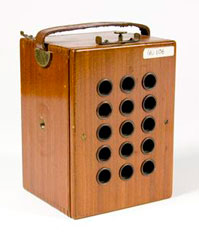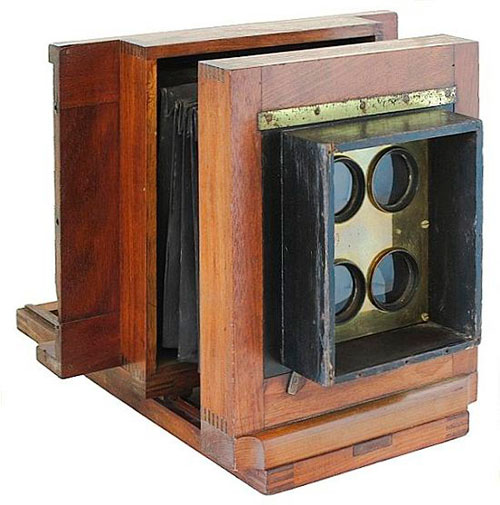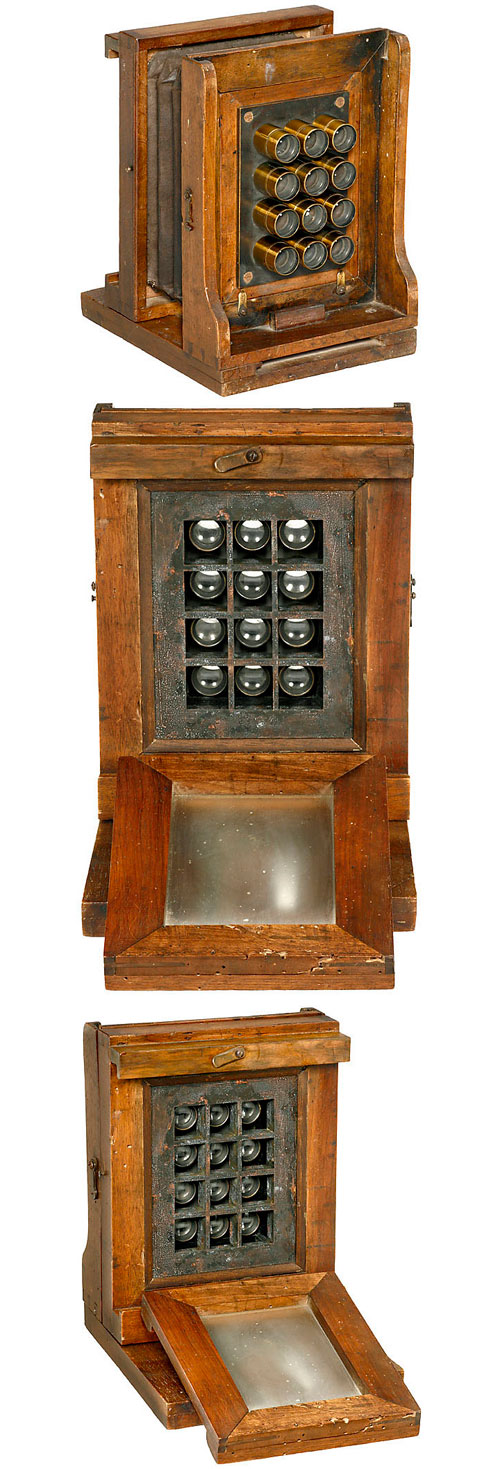Photo Gear History: With the Multiplying Camera, the More Lenses, the Better
posted Friday, April 27, 2012 at 4:56 PM EDT
 Sitting for your picture in a Daguerreotype photographer’s studio in the middle of the 19th century was a form of torture for both sitter and photographer. An agonizing experience, it required the subject to sit for several minutes, immobile while clamped into neck braces and head supports.
Sitting for your picture in a Daguerreotype photographer’s studio in the middle of the 19th century was a form of torture for both sitter and photographer. An agonizing experience, it required the subject to sit for several minutes, immobile while clamped into neck braces and head supports.
For the portrait photographer, it was a struggle too. There was no question of taking a dozen shots and picking the best one. It was about getting the shot the first time, well before the sitter began to pass out and keel over.
Daguerreotypes were not negatives from which prints could be made; even though they were negatives. This meant that if the customer wanted extra pictures for family and friends, they were just out of luck. This was both artistically and economically frustrating for photographers, who could see that they were missing sales. But what could they do?
The solution came from the fertile minds of tinkerers and early camera makers, their names mostly lost in time. Within a decade of the invention of photography, they built all sorts of versions of the “Multiplying Camera.” Each was a single shot camera with multiple lenses. The number of lenses varied with some cameras having 4 lenses others 8, 9, 15 or a few a even a whopping 36 lenses. And the lenses were adjusted so that every one of the multiple images were exactly the same.
The design was so popular that even after the development a workable (glass plate) negative/positive process and the ability to make unlimited prints, the Multiplying cameras remained in use. And why not? Just take a look at these exquisite Argus eyed monsters.
 The first Multiplying camera, like the 4 lens “Bon Ton," was made around 1854 by Andre Adolphe Disderi, who had devised a way to make Carte de Visite multiple images on a single photographic plate. Carte de Visite photographs are small prints mounted on cards that are roughly 2-1/2 by 4 inches and were used just as business cards are today.
The first Multiplying camera, like the 4 lens “Bon Ton," was made around 1854 by Andre Adolphe Disderi, who had devised a way to make Carte de Visite multiple images on a single photographic plate. Carte de Visite photographs are small prints mounted on cards that are roughly 2-1/2 by 4 inches and were used just as business cards are today.
Topping the 4-lens Bon Ton, is the 9-lens (circa1860s) Carte de Visite Wet Plate Camera, labeled Scovill Manufacturing Co, NY (1849-1889). This is a “Gem” camera, because of the small gemlike size of the images, although there is no standard size for "gem" images.
Next, here is a very rare 1865, French Multiplying camera with 12 brass lenses. It makes twelve ¾ x ¾ inch (2x2cm) images on a plate about 2 5/8 x 4 inches (7 x 10 cm). It is dwarfed by an even rarer 36-lens Roberts 1858 multi-lens tintype camera. Tintypes are one shot images and like Daguerreotypes, both of which are underexposed negative images that look positive because they are on a dark metal background and usually under a coat of varnish.
My favorite Multiplying Camera, though, is the beautiful Butcher Royal Mail Stamp Camera. It is the simplest type of multiplying camera, not much more than an elegant, beautifully polished, mahogany box with fifteen lenses. Inside the box, there is a spring mounted metal plate shutter and thin pieces of wood that separate the lenses.
Royal Mail Stamp Camera takes fifteen images on small 3-1/4" x 4-1/4" dry plates or film. The resulting 3/4" x 7/8" photographs were much smaller than Carte de Visites, "Bon Tons" and "Gems." These cameras were very popular and over the years modified to take different lens combinations, and sensitized material. They were popular attractions at country fairs and traveling circuses and sideshows where couples and families would line up at the Stamp Camera stand to get their photos taken.
The name Stamp Camera has little to do with the postal service. From the start, Stamp Cameras outfits included perforated printing-out-paper on which the 15 pictures were printed postage stamp size. These Stamp Cameras were so successful that the printing-out-paper for later versions produced stamp-like photos complete with perforations and gummed backs.
The Multiplying Camera is such an excellent idea, I wonder why no one has made a hybrid digital/Multiplying Camera yet?
